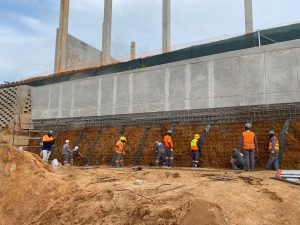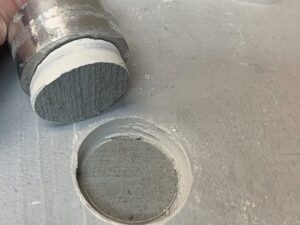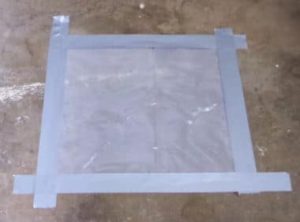By Sheldon White
Our colloidal silica post-placement pozzolan technology reduces moisture vapour transmission to levels that are low enough for most moisture-sensitive flooring materials according to ASTM E 96 test results.
Colloidal silica is unique
Colloidal silica-post-placement pozzolan technology is unique and differs significantly to many other moisture mitigation treatments. Our technology does not form a coating or membrane on the surface of the concrete. Rather, SCP penetrates the concrete matrix. It then fills the concrete capillaries, pores and voids that are formed as bleed water exits. This stops or significantly slows down water vapour transmission.
Colloidal silica reacts to form C-S-H
When colloidal silica post-placement pozzolan technology reacts with available alkalis, it primarily forms Calcium Silicate Hydrate (C-S-H) inside the voids, capillaries and pores of concrete. C-S-H is the same reaction product that is produced by cement hydration which gives most of concrete’s desirable properties. This process allows for longer hydration of the concrete.
Testing colloidal silica-treated substrates unnecessary
Moisture testing colloidal silica post-placement pozzolan-treated substrates is unnecessary for our warranty and SCP does not warrant any test results. As is the case with any remediation system for moisture, flooring or coating, SCP should be applied according to the manufacturer’s directions without further testing.
Colloidal silica-treated concrete
However, there is a test method that can be used to measure water-vapour transmission through the matrix of colloidal silica post-placement pozzolan-treated concrete. The method is formally known as the ASTM D 4263-83 (reapproved 2018) Standard Test Method for Indicating Moisture in Concrete by the Plastic Sheet Method.
When performing this test method, coverings, coatings and adhesives have to be removed. Although the standard states a minimum of 16 hours for testing, SCP recommends at least 24 hours. However, 72 hours is preferred. When performing this test, the plastic sheeting should also be placed on an area of the surface that is not located near an opening, crack, joint, or penetration.
Colloidal silica and contractors
However, there is sometimes uncertainty regarding the need to test colloidal silica post-placement-pozzolan-treated substrates for moisture vapour transmission among flooring and coating contractors. There is also ambiguity around the testing methods that are to be used. For example, some contractors still incorrectly request Moisture Vapour Emission Rate (MVER) and Relative Humidity (RH) tests for concrete that has been treated with SCP.
MVER testing is formally referred to ASTM F1869-16a Standard Test Method for Measuring Moisture Vapor Emission Rate of Concrete Subfloor Using Anhydrous Calcium Chloride. The method explicitly states that it cannot be used to evaluate the rate of moisture vapour emitted by gypsum concrete or floors containing lightweight aggregate. The method also clearly notes that it cannot be used to evaluate moisture vapour emissions over coatings on concrete or through reactive penetrants or over patching or levelling compounds.
The RH test is formally referred to as ASTM F2710 Standard Test Method for Determining Relative Humidity in Concrete Floor Slabs Using In-Situ Probes. It determines the relative humidity in the concrete matrix by embedding a probe into concrete and then taking a reading once it has acclimated to its surroundings.
SCP products trap moisture in the concrete by filling the capillaries and void spaces. The reaction products that are formed fill the capillaries and voids and shutdown liquid water transmission. By trapping the moisture in the concrete, the relative humidity will typically remain high for an extended time period.






